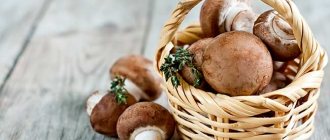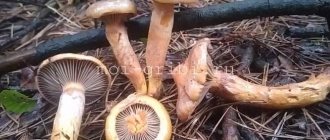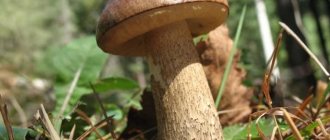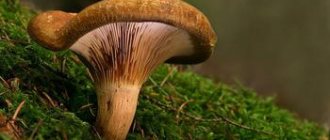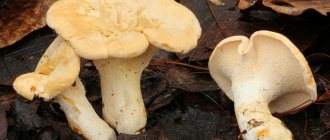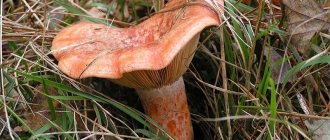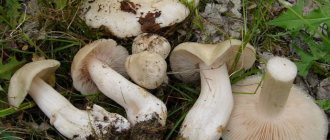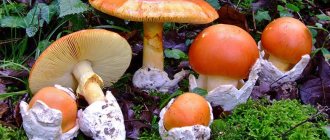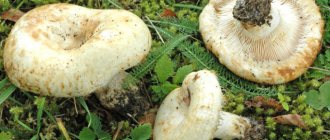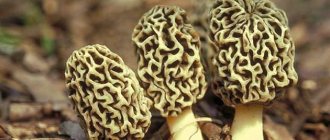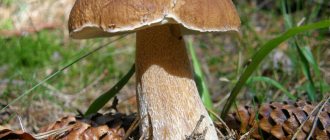Boletus mushrooms (boletus mushrooms)
Strong boletus mushrooms, close relatives of boletus mushrooms, belong to the genus Obabok and are considered mushrooms of excellent quality. As the name indicates, they are in symbiosis with birches, often developing under these trees. However, this does not always happen - various species can be found on the outskirts of swamps, in dry pine forests or in beech groves.
Obabok and boletus - are they the same thing or not?
According to the classification, boletus mushrooms are indeed little birds; they are part of the genus with that name. But at the same time, not every mushroom is an ordinary boletus, because other types of mushrooms are also called by this word.
In particular, the obobkaks include:
- boletus - gray, or hornbeam, harsh, marshy, black, pinkish and multi-colored;
- boletus - black-scaled, red, white, yellow-brown;
- redheads - spruce, pine and oak;
- Far Eastern and blackening obobki.
All these mushrooms belong to the edible or conditionally edible categories, have similar structural features, but can differ greatly in color.
Related species
Boletus is a group of species of mushrooms of the genus Leccinum (boletus). In addition to boletus, this genus includes a group of boletus. One of the distinguishing features of the representatives of the two groups is that in the latter the flesh turns blue at the break, while in the boletus it remains white or slightly yellow. An exception is the pink boletus, whose flesh oxidizes in air and acquires a pinkish tint. Representatives of both groups are edible mushrooms.
In addition to the common boletus species, boletus species include several dozen species. The most common:
- gray boletus (hornbeam) – Leccinum carpini;
- Stiff boletus – Leccinum duriusculum;
- marsh boletus – Leccinum holopus;
- black boletus (black cap) – Leccinum melaneum;
- pink boletus – Leccinum oxydabile;
- checkerboard boletus (blackening) – Leccinum nigrescens;
- ash-gray boletus – Leccinum leucophaeum;
- colorful boletus – Leccinum variicolor.
Where do babies grow?
The boletus and aspen boletuses, which belong to the genus of boletuses, choose mainly deciduous forests or mixed plantings for their growth. They are found everywhere in regions with a temperate climate, and are also found in subtropical and northern regions.
A distinctive feature of the genus is the desire to form a symbiosis with the roots of deciduous trees. Boletus and aspen boletuses are not found in open spaces; they settle directly under the trunks of aspens, birches, oaks, beeches, hornbeams and other trees.
Secrets for mushroom pickers
- Look not only under birches, but also under other trees. Despite the name, boletus mushrooms often settle under poplars, oaks, and aspens.
- The earliest seeds appear in June; they should be collected on forest edges, warmed by gentle gentle rays of the sun, where humidity reigns. And closer to autumn - move deeper into the forest.
- The most delicious boletus mushrooms are young and small in size. It is better to refuse to collect overgrown old specimens.
- To preserve mushrooms for the winter, you can choose one of the popular processing methods: pickling, freezing, pickling or drying. This will help in the cold winter to please yourself and your family with delicious mushrooms and remember the smell of the autumn forest.
Boletus is rightfully considered one of the most delicious representatives of the mushroom kingdom. The possibilities for using them in cooking are truly endless; the resulting dishes are aromatic and nutritious, perfectly satisfy hunger and become true decorations for any table.
What does a dog look like?
The photo of the obtuses shows that, depending on the specific variety, they may differ in appearance. However, a general description can be given to this genus of mushrooms.
The caps of the little ones are quite large, on average 10-15 cm in diameter, most often of a hemispherical convex shape, but sometimes also spread out. The surface of the caps can be felt, velvety or smooth, but they are not characterized by shine; usually their skin is matte.
Caps belong to the category of tubular mushrooms, so the underside of their caps is porous and easily separated. The tubes themselves are yellowish, grayish or almost white in color, with small pores. In young mushrooms, the tubular layer is lighter; with age, the shade becomes darker.
Obabkas are characterized by a cylindrical high leg up to 10 cm and higher. There is usually a slight thickening below, the surface of the leg is fibrous or scaly, for example, like in boletus mushrooms.
If you break or cut the egg, its flesh will be white, but upon contact with air it will quickly change color to dark blue, black or reddish. After cooking and subsequent culinary processing, the mushrooms turn black; this is completely normal for these mushrooms.
Cooking recipes
Zucchini stuffed with mushrooms
Ingredients: zucchini (medium) – 1 pc., boletus mushrooms (fresh) – 300 gr., chicken breast – 1 pc., rice – 1 handful, onion – 1 medium head, tomatoes (large) – 2 pcs., sour cream – 3 tbsp, hard cheese – 50 g, garlic – 3 large cloves, vegetable oil – 2 tbsp, herbs, for example parsley – 5 sprigs, salt, ground black pepper.
Preparation
Cut the prepared, well-washed mushrooms into small cubes. Simmer in a frying pan until almost all the liquid has evaporated. Add vegetable oil and fry until golden brown.
Transfer the prepared mushrooms, straining off the oil, to a plate.
- Peel the onion, chop finely and simmer in the remaining oil from frying the mushrooms until soft.
- Rinse the rice well. Wash the meat, dry it lightly with a napkin, cut into cubes. Finely chop the greens (parsley).
- Combine all the minced meat ingredients: mushrooms, onions, rice, meat, herbs, add salt, spices and mix well.
- Wash the zucchini, peel and cut into barrel slices 5-6 cm thick. Cut out the core of each barrel, leaving a thin bottom, thus forming a glass.
- Fill the prepared cups with minced meat. Since the rice cooks and increases in volume during the cooking process, you should put a lot of minced meat in each cup and should not compact it.
- Wash the tomatoes, pour over boiling water, remove the skin and grind with a blender. Rub the resulting mass through a sieve. Add sour cream, salt, spices, chopped garlic and 100 ml. water.
- Place the zucchini filled with minced meat in a mold with high sides and pour in tomato-sour cream sauce. Add warm boiled water to the top of each glass.
- Heat the oven to 240°C. Cover the dish with the zucchini and bake for about 40 minutes. Then remove the lid, sprinkle each zucchini cup with cheese grated on a coarse grater and bake at high heat for another 5-7 minutes (until the cheese is browned).
- When serving, the zucchini is poured with the tomato-sour cream sauce in which they were stewed.
Why is it called that?
The unusual name of the genus arouses interest - at first glance it seems completely incomprehensible. The word is deciphered quite simply - in some Russian regions, for example, near Pskov, Novgorod and Arkhangelsk, the dialect word “baba” is used to describe stumps and fallen trees.
If “baba” is a stump, then, accordingly, “baba” are mushrooms growing not far from the stump, around it. It is curious that this word is used only for boletus and aspen mushrooms, although the location near trees is also typical for many other mushrooms, for example, honey mushrooms.
Black boletus
- Latin name: Leccinum melaneum.
He is also a blackhead . Similar to the common boletus, but noticeably darker in color.
Just like the previous mushroom, it loves moisture, so it grows in almost the same places. There is information that it is capable of forming mycorrhiza not only with birch , but also with pine .
Is it possible to eat bastards?
Mushrooms from the genus obabok are completely suitable for food use. Moreover, they belong to the delicacy category; collecting a full basket of boletus and boletus is considered a great success. Minimal processing is required, there is no need to soak the fruiting bodies for a long time, and the taste of the mushrooms is very pleasant and mild.
Obabki are suitable for any culinary processing. Most often they are boiled, pickled and fried, and delicious mushrooms can also be dried. Dried boletus and boletus can be stored for a very long time, and they are most often used to add to soups and other hot dishes.
Important! It is not the caps that are most loved by gourmets, but the stems of the fruiting bodies. Unlike caps, they retain their dense structure well after heat treatment and remain strong and pleasant.
Boletus checkerboard
- Latin name: Leccinum nigrescens.
He is also the blackening boletus . This mushroom is not very similar to ordinary boletus mushrooms, it is more reminiscent of a porcini mushroom or even an oil can (at a very young age). Because of this, there is some risk of confusion with the inedible gall fungus, which is usually lighter in color but at times quite similar. The surest distinguishing feature is the taste of the pulp; it should not be bitter. Also, mature fruiting bodies of boletus chess often have a cracked cap surface.
Mycorrhiza forms with broad-leaved trees - such as oak and beech , and is found in the southern regions of Europe. Fruits from June to September .
A very interesting fact is that in some sources this mushroom is referred to as chess boletus (it is also described in the corresponding article about boletus). But, given that neither birch nor aspen are the main preferences of this example of forest flora, it would be more correct to call it checkerboard . By the way, it is precisely under this name that it is known in the circles of mycological scientists [2] Mycology is the science that studies mushrooms..
False little jokes
The appearance of the mushrooms is quite expressive; these mushrooms are difficult to confuse with other edible or even more so poisonous mushrooms. However, the possibility of error still exists, especially for inexperienced foragers just starting to study edible mushrooms.
Bile mushroom
Most of all, in appearance, the boletus resembles bitterweed; it is also called gall mushroom or false boletus. It is similar to edible mushrooms in size and structural features. In particular, the false double has a large convex cap in the shape of a hemisphere, a brown-brown or gray-brown skin color, and a tubular lower surface of the cap. The gall mushroom also grows on a strong cylindrical stalk of a light color.
The main difference between bittergrass, which allows it to be distinguished from bitterling, is the pattern on the stalk, a little reminiscent of blood vessels. In boletus and boletus, the leg is covered with scales and looks completely different.
Another distinctive characteristic of the gall fungus is its sharp bitter taste, which cannot be confused with the taste of edible mushroom. Moreover, after boiling and subsequent heat treatment, the bitterness does not disappear, but even intensifies. But in order to check this difference, you would have to taste the mustard, and this is not recommended; it is better to focus on external signs.
The gall mushroom does not have poisonous properties, and accidental consumption does not cause significant harm to health. But the taste of the mushroom is too pungent, so any dish that contains bitter bitter will be hopelessly spoiled.
Advice! If the mushroom is old, then you can also recognize it as a mustard by its pulp, untouched by insects; the cap and stem are so bitter that even worms and forest flies do not use them as food.
Death cap
In the absence of experience, the edible toadstool can be confused with the most poisonous and dangerous mushroom in Russia - the pale toadstool. Its leg can also be cylindrical and quite dense; the toadstool and toadstool are similar in size and shape of the cap. The skin of the toadstool is often yellowish-brown, almost the same as that of boletus and boletus. In addition, this poisonous mushroom very often grows under aspen, beech and birch trees, exactly where mushroom pickers expect to find edible mushrooms.
But the differences between species are very noticeable. The pale grebe is characterized by:
- plates on the lower surface of the cap, while caps are tubular mushrooms;
- absence of characteristic scales on the leg - the toadstool's leg is smooth and even, sometimes it has a moire pattern;
- a peculiar thickening at the base of the stem, it looks like a separate part of the fruiting body, and is not at all similar to the thickening in boletuses and boletuses.
But the famous ring on the leg of the pale grebe is not always found. The ring represents fragments of the covering of the fruiting body and is usually present in young mushrooms, but most often disappears with age. Therefore, it is worth focusing on those signs and differences that persist throughout the entire life cycle.
Stiff boletus (Leccinum duriusculum)
- Other names for the mushroom:
- Boletus firma
- Obabok is harsh
- Poplar boletus
- Obabok is a little hard
Other names:
- The boletus is hard;
- Poplar boletus;
- Obabok is a bit harsh;
- The obabok is hard;
- Boletus duriusculus;
- Leccinum nigellum.
External description
The fruiting body of the stiff boletus consists of a stem and a cap. The flesh of the mushroom is white and very hard, but if you make a cut on the cap, it turns reddish. If the base of the leg is damaged, the flesh becomes bluish, and after a while acquires a gray-black tint. The aroma of the pulp of the harsh boletus is weak, the smell of mushroom is different, and the taste is pleasant.
The diameter of the cap varies between 6-15 cm. The shape of young boletus mushrooms is convex and hemispherical, and in mature fruiting bodies it becomes cushion-shaped. The skin of the mushroom initially has a small edge, which, as it ripens, completely disappears and the mushroom remains naked. With high air humidity, the surface of the cap becomes slimy, with drooping edges. The color of the cap can be grayish-brown, gray-brown, ocher-brown, gray-brown.
The mushroom hymenophore is tubular. The tubes have a length of 10 to 25 mm, are initially white, gradually become creamy yellow, and when pressed change color to grayish-brown or olive-brown. The constituent components of the hymenophore are spores characterized by an ellipsoid-spindle-shaped or ellipsoidal shape. The color of the spore powder varies from ocher-brown to light ocher. The spore sizes are 14.5-16 – 4.5-6 microns.
The length of the mushroom stalk varies between 40-160 mm, and its diameter is 10-35 mm. It is spindle-shaped or cylindrical in shape, and can sometimes be pointed at the base. The upper part of the mushroom stalk is characterized by a whitish color, and bluish spots are often noticeable at the base. The color of the leg below is brownish, and its entire surface is covered with brown scales.
Season and habitat of the mushroom
The harsh boletus grows in mixed and deciduous forests, directly on the soils. It has the ability to form mycorrhiza with poplars and aspens. This mushroom can be found both in groups and in single growth. The tough boletus prefers to grow on calcareous soils. Rarely, but you can still find this type of boletus on loam and sandy soils. Fruiting of the mushroom occurs from mid-July to the end of October (sometimes the fruiting bodies of the harsh boletus can be found in mid-November). In the last few years, more and more information has appeared that the boletus mushroom is spreading more widely, it is being found more and more often and in large quantities.
Edibility
The hard boletus is an edible mushroom, which, compared to other types of boletus, has a much denser flesh. It very rarely harbors worms, and it is recommended to consume the harsh boletus in dried or fresh form. It is used to prepare various delicious dishes.
Similar types and differences from them
The described species is similar to many other varieties of boletus. However, the harsh boletus has no similarities with poisonous or inedible mushrooms.
Taste qualities of mushrooms
Boletus and boletus fall into the category of noble or delicious mushrooms. According to gourmet reviews, their taste is second only to porcini mushrooms. Obabki can be a good addition to almost any dish.
At the same time, opinions about the taste of the caps and legs of the caps differ sharply. Mushroom pickers prefer to eat the strong, hard and elastic legs of fruiting bodies. But the caps are much less popular because they become very boiled and acquire an unpleasant, overly soft consistency.
Gray boletus
- Latin name: Leccinum carpini.
He is also a hornbeam . It is very similar in appearance to an ordinary boletus, but it can be distinguished by the color of the flesh when cut - at first it turns pink, then darkens to gray or almost black. Also, this mushroom is often somewhat smaller and denser, the surface of its cap becomes uneven and wrinkled with age.
It is found in the southern regions of the European part of the continent - in forests where hornbeam . Occasionally forms mycorrhiza with birch , hazel or poplar . Fruits from June to October .
Benefits and harm to the body
In cooking, obabki are valued not only for their pleasant taste. Mushrooms of this genus have a beneficial effect on the body, since they contain many useful compounds. Mushroom pulp contains:
- vitamins - B1 and B2, PP;
- vitamins E and D;
- ascorbic acid and thiamine;
- potassium and iron;
- magnesium and phosphorus;
- manganese and calcium;
- amino acids - arginine, glutamine and leucine;
- cellulose;
- a huge amount of vegetable protein.
The beneficial effect of boletus on the body is expressed in the fact that boletus and aspen boletus:
- help improve blood composition and build muscle mass;
- improve metabolism and help the body get rid of toxins;
- balance blood sugar levels and remove toxins;
- normalize the functioning of the liver and kidneys;
- compensate for the lack of vitamins and mineral salts;
- stimulate the immune system and strengthen resistance to diseases.
However, if used carelessly, mushrooms can exhibit their harmful qualities. First of all, it is not recommended to use them if you have an individual intolerance, in which case even a small amount of mushroom pulp will lead to poisoning.
It is also not recommended to eat obabki:
- with pancreatitis and ulcers in a state of exacerbation;
- with frequent constipation and sluggish digestion.
Attention! It is better not to offer mushrooms to children under 7 years of age, although mushrooms are completely harmless, they contain too much protein, and it will be difficult for a sensitive stomach to digest them.
Chemical composition
The benefits of common boletus are determined by the components in its composition. The mushroom is rich in vitamins, macro- and microelements and is a valuable food product. It contains vitamins A, C. E, D, H, PP, B vitamins (B1, B2, B9), as well as potassium, phosphorus, magnesium, sodium, manganese, iron, cobalt, zinc, etc.
In addition, proteins (30-35%) were found in the common boletus, including amino acids such as tyrosine, leucine, glutamine, arginine, fats, mono- and disaccharides, fiber, and organic acids.
Use
Since the taste of the delicious fruiting bodies is second only to porcini mushrooms, mushrooms are used truly everywhere in cooking. Boiled mushrooms are added to salads and snacks, birch and aspen mushrooms are fried and eaten with potatoes and meat, their legs and caps add an unusual and very pleasant taste to hot soups. Also, the fruiting bodies are often dried and pickled for the winter - you can enjoy the taste of the fruit even in the cold winter months.
Edible fruit bodies do not require special processing before cooking. There is no need to soak them, just clean the mushrooms from debris, remove the skin from the stem and cut off the tubular layer on the cap. After this, the raw materials are washed and immediately sent to boil in salted water for 30-40 minutes, and after the first 5 minutes of cooking, the water is drained and replaced with fresh water.
In addition to cooking, birch and aspen trees are used for medicinal purposes. They are suggested to be used in many folk health recipes. It is believed that infusions and tinctures of these mushrooms:
- have a beneficial effect on kidney health;
- help get rid of inflammatory diseases;
- have a good effect on diabetes;
- have a calming and relaxing effect.
Low-calorie fats can be found as part of weight loss diets. Due to their high protein content, aspen and birch trees fill you up well and help get rid of hunger. But it is impossible to gain weight on mushrooms if you eat properly, so for weight loss the effect will only be positive.
Contraindications
Whatever the useful product and whatever gastronomic qualities it has, before use you should always take into account not only the benefits, but also the contraindications of the black boletus. The mushroom is not recommended for use if:
- exacerbation of chronic gastritis,
- women during lactation,
- having an allergy to mushrooms.
If you are prone to allergic reactions, you need to be careful and include black boletus in your diet gradually, starting with a small amount. Since mushrooms are a rather difficult product for the digestive system, they are not recommended for children under 7 years of age.
Since mushrooms are a rather difficult product for the digestive system, they are not recommended for children under 7 years of age.
Literature:
Lesso T. Mushrooms. Determinant.
Yu.G. Khatskevich. Reference guide. Mushrooms
Varieties
boletus
The old guy has a poisonous double
The fruiting period of boletus begins at the end of May and continues until the last days of October.
Edible varieties:
- ordinary, or subgrown - cap with a diameter of 5-15 cm, color from gray to brownish-brown, varies depending on the weather, mushroom pulp is dense, watery, grows in birch and mixed forests, fruiting period - late May - October;
- hornbeam - a cap with a diameter of 6-20 cm, the color is brown-gray, the mushroom pulp is cotton-like, acquires a purple hue when cut, grows in deciduous forest belts from July to September;
- black - cap with a diameter of 5-20 cm, black-brown color, mushroom pulp is dense, elastic, with a sweetish taste, grows in wetlands in forests with birch, fruiting period - July-September;
- pinkish - cap with a diameter of 8-18 cm, color brownish-gray, mushroom pulp is fibrous, changes to pinkish when cut, grows in damp birch forests and pine-birch forest belts, fruiting period - July-October;
- white - cap diameter 4-15 cm, color off-white, mushroom pulp is watery, often does not change white color when cut, but sometimes turns blue, taste is fresh, smell is weak, grows in birch forests and mixed forests near swamps, fruiting period - second half of July-October.
The edible boletus obabok has a false twin, called gall boletus, which is distinguished by its pronounced bitterness.
Boletus
Mushroom appearance time:
- in the last days of June, but the harvest is not abundant, such mushrooms are called spikelets;
- in mid-July, stubble trees grow en masse;
- from the end of August to the end of September, deciduous plants appear in large numbers.
During the wet summer season, between the growth stages of boletuses, single fruiting is observed.
Commonly found edible varieties:
- red, or redhead - a cap with a diameter of 5-20 cm, the color depends on the place of growth: in poplar forests it has a gray tint, in aspen forests it is dark red, in mixed forests it is orange-red. Fruiting period - from June to October,
- white - cap with a diameter of 4-20 cm, light brown color, mushroom pulp is hard, turns blue when cut, grows in aspen and mixed forests, fruiting period - June-September,
- hogweed - cap with a diameter of 8-20 cm, red-brown color. The pulp is dense, turns black when cut, grows in dry places among mosses, fruiting period is June-September.
Boletus has a false, conditionally edible counterpart, called bitterling, which contains a characteristic bitterness.
Blue boletus
- Latin name: Leccinum cyaneobasileucum.
Another fungus that can sometimes be confused with a gall fungus. It got its name from the property of the stem turning blue when cut in its lower part.
In terms of places of growth and timing of fruiting, it is similar to ordinary apes, but is more moisture-loving, especially loving places overgrown with moss.
Tundra boletus
- Latin name: Leccinum rotundifoliae.
This is probably the most severe of all the ones listed in this article. It prefers northern latitudes to southern ones and grows in forest-tundra and tundra.
Mycorrhiza forms not only with ordinary birch , but also with dwarf birch .
One old northern joke is associated with the preference of boletus to enter into symbiosis with tundra dwarf birch trees. Often these mushrooms are taller than the symbiont plant, for which they are jokingly nicknamed “birch mushrooms.”
Smoky boletus
- Latin name: Leccinum schistophilum.
Another mushroom is a lover of damp places, growing in damp forests - in moss, near swamps. It differs from other monkeys in the bluish-smoky shade of its cap.
Like most of its fellows, it is found where birch trees . Quite rare.
Beneficial features
The obabok mushroom not only has a pleasant taste and aroma, but also contains a large amount of useful substances:
- protein;
- fats;
- carbohydrates;
- alimentary fiber;
- water;
- ash;
- monosaccharides;
- disaccharides;
- minerals;
- fatty acid.
In addition, the mushroom contains vitamins and microelements:
- vitamin B;
- vitamin E;
- ascorbic acid;
- sodium;
- magnesium;
- phosphorus;
- iron;
- manganese;
- potassium;
- calcium.
Although the mushroom contains a rich set of elements and vitamins, the mushroom is still considered a low-calorie product, since it contains easily digestible proteins and amino acids:
- tyrosine;
- glutamine;
- leucine;
- arginine
Thanks to the dietary fiber contained in the mushroom, harmful wastes and toxins are eliminated from the body through urine.
Nutritional value of the product:
| Fats | Squirrels | Carbohydrates | Calorie content |
| 90 g | 2.3 g | 3.7 g | 31 |
Boletus variegated
- Latin name: Leccinum variicolor.
It is similar to an ordinary monkey, but has a characteristic feature - light spots in color, which makes it look very motley. Also, when cut, its flesh turns pink - in the cap and the upper part of the stem, and turquoise - at the base of the stem.
In other respects (including in the places of growth and timing of fruiting) the mushroom is similar to the ordinary boletus.
